-

新人教版高中英语必修3Unit 3 Diverse Cultures教学设计三
The price is the same as(the price was)before the war.价格与战前相同。(4)定语从句中的“关系代词+助动词be”可以省略。The ticket(that/which was)booked by his sister has been sent to him.他妹妹订的那张票已送到了他那里。Step 5 PracticeActivity 3(1) Guide students to complete the four activities in the Using Structures part of exercise book, in which activities 1 and 2 focus on ellipsis in dialogue answers, activity 3 focus on signs and headlines, two typical situations where ellipsis is used, and activity 4 focus on ellipsis in diary, an informal style.(2) Combine the examples in the above activities, ask students to summarize the omitted situations in groups, and make their own summary into a poster, and post it on the class wall after class to share with the class.(This step should give full play to the subjectivity of students, and teachers should encourage students to conclude different ellipsis phenomena according to their own understanding, they can conclude according to the different parts omitted in the sentence.)Step 6 Homework1. Understand and master the usages of ellipsis;2. Finish the other exercises in Using structures of Workbook.1、通过本节内容学习,学生是否理解和掌握省略的用法;2、通过本节内容学习,学生能否根据上下文语境或情景恢复句子中省略的成分,体会使用省略的效果;3、通过本节内容学习,学生能否独立完成练习册和导学案中的相关练习。

新人教版高中英语必修3Unit 3 Diverse Cultures教学设计四
该板块的活动主题是“介绍一个有显著文化特征的地方”( Describe a place with distinctive cultural identity)。该板块通过介绍中国城继续聚焦中国文化。本单元主题图呈现的是旧金山中国城的典型景象, Reading and Thinking部分也提到中国城,为该板块作铺垫。介绍中国城的目的主要是体现中国文化与美国多元文化的关系,它是美国多元文化的重要组成部分。中国城也是海外华人的精神家园和传播中国文化的重要窗口,外国人在中国城能近距离体验中国文化。1. Read the text to understand the cultural characteristics of Chinatown in San Francisco and the relationship between Chinese culture and American multiculturalism;2. Through reading, learn to comb the main information of the article, understand the author's writing purpose and writing characteristics;3. Learn to give a comprehensive, accurate, and organized description of the city or town you live in;Learn to revise and evaluate your writing.Importance:1. Guide the students to read the introduction of Chinatown in San Francisco and grasp its writing characteristics;2. Guide students to introduce their city or town in a comprehensive, accurate and organized way;3. Learn to comb the main information of the article, understand the author's writing purpose, and master the core vocabulary.

新人教版高中英语必修3Unit 3 Diverse Cultures教学设计一
Activity 81.Grasp the main idea of the listening.Listen to the tape and answer the following questions:Who are the two speakers in the listening? What is their relationship?What is the main idea of the first part of the listening? How about the second part?2.Complete the passage.Ask the students to quickly review the summaries of the two listening materials in activity 2. Then play the recording for the second time.Ask them to complete the passage and fill in the blanks.3.Play the recording again and ask the students to use the structure diagram to comb the information structure in the listening.(While listening, take notes. Capture key information quickly and accurately.)Step 8 Talking Activity 91.Focus on the listening text.Listen to the students and listen to the tape. Let them understand the attitudes of Wu Yue and Justin in the conversation.How does Wu Yue feel about Chinese minority cultures?What does Justin think of the Miao and Dong cultures?How do you know that?2.learn functional items that express concerns.Ask students to focus on the expressions listed in activity. 3.And try to analyze the meaning they convey, including praise (Super!).Agree (Exactly!)"(You're kidding.!)Tell me more about it. Tell me more about it.For example, "Yeah Sure." "Definitely!" "Certainly!" "No kidding!" "No wonder!" and so on.4.Ask the students to have conversations in small groups, acting as Jsim and his friends.Justin shares his travels in Guizhou with friends and his thoughts;Justin's friends should give appropriate feedback, express their interest in relevant information, and ask for information when necessary.In order to enrich the dialogue, teachers can expand and supplement the introduction of Miao, dong, Lusheng and Dong Dage.After the group practice, the teacher can choose several groups of students to show, and let the rest of the students listen carefully, after listening to the best performance of the group, and give at least two reasons.

新人教版高中英语选修2Unit 4 Learning about Language教学设计
This section guides students to pay attention to the typical context of vocabulary use, helps students accumulate vocabulary around the key vocabulary of this unit, and uses the learned words and word chunks in different contexts to deeply understand their meaning and usage, so as to achieve the purpose of review and consolidation.The teaching design activities aim to guide students to pay attention to the typical context in which the target vocabulary is used, as well as the common vocabulary used in collocation, so that students can complete the sentence with correct words. In terms of vocabulary learning strategies, this unit focuses on cultivating students' ability to pay attention to collocation of words and to use word blocks to express meaning.For vocabulary learning, it is not enough just to know the meaning of a single word, but the most important thing is to master the common collocations of words, namely word blocks.Teachers should timely guide students to summarize common vocabulary collocation, such as verb and noun collocation, verb and preposition collocation, preposition and noun collocation, and so on.1. Guide students to understand and consolidate the meaning and usage of the vocabulary in the context, 2. Guide the students to use the unit topic vocabulary in a richer context3. Let the students sort out and accumulate the accumulated vocabulary, establishes the semantic connection between the vocabulary,4. Enable students to understand and master the vocabulary more effectivelyGuiding the Ss to use unit topic words and the sentence patterns in a richer context.

新人教版高中英语选修2Unit 4 Using langauge-Listening教学设计
The theme of the listening section is " talking about scenery and culture along a journey."The part is designed to further lead the students to understand Canadian natural geography and social environment, and integrated into the cultural contrast by mentioning the long train journey from Beijing to Moscow routes. On this basis, the part activates students related travel experience, lets the student serial dialogue, guides the student to explore further the pleasure and meaning of the long journey, and Chinese and foreign cultural comparison.The part also provides a framework for the continuation of the dialogue, which is designed to provide a framework for students to successfully complete their oral expressions, and to incorporate an important trading strategy to end the dialogue naturally.1. Help students to understand and master some common English idioms in the context, and experience the expression effect of English idioms.2. Guide the students to understand the identity of different people in the listening context, and finish the dialogue according to their own experience.3. Instruct the students to use appropriate language to express surprise and curiosity about space and place in the dialogue, and master the oral strategy of ending the dialogue naturally.1. Instruct students to grasp the key information and important details of the dialogue.2. Instruct students to conduct a similar talk on the relevant topic.

新人教版高中英语选修2Unit 5 Learning about Language教学设计
The purpose of this section of vocabulary exercises is to consolidate the key words in the first part of the reading text, let the students write the words according to the English definition, and focus on the detection of the meaning and spelling of the new words. The teaching design includes use English definition to explain words, which is conducive to improving students' interest in vocabulary learning, cultivating their sense of English language and thinking in English, and making students willing to use this method to better grasp the meaning of words, expand their vocabulary, and improve their ability of vocabulary application. Besides, the design offers more context including sentences and short passage for students to practice words flexibly.1. Guide students to understand and consolidate the meaning and usage of the vocabulary in the context, 2. Guide the students to use the unit topic vocabulary in a richer context3. Let the students sort out and accumulate the accumulated vocabulary, establishes the semantic connection between the vocabulary,4. Enable students to understand and master the vocabulary more effectivelyGuiding the Ss to use unit topic words and the sentence patterns in a richer context.Step1: Read the passage about chemical burns and fill in the blanks with the correct forms of the words in the box.

新人教版高中英语选修2Unit 5 Using langauge-Listening教学设计
The theme of this section is to learn how to make emergency calls. Students should learn how to make emergency calls not only in China, but also in foreign countries in English, so that they can be prepared for future situations outside the home.The emergency telephone number is a vital hotline, which should be the most clear, rapid and effective communication with the acute operator.This section helps students to understand the emergency calls in some countries and the precautions for making emergency calls. Through the study of this section, students can accumulate common expressions and sentence patterns in this context. 1.Help students accumulate emergency telephone numbers in different countries and learn more about first aid2.Guide the students to understand the contents and instructions of the telephone, grasp the characteristics of the emergency telephone and the requirements of the emergency telephone.3.Guide students to understand the first aid instructions of the operators.4.Enable Ss to make simulated emergency calls with their partners in the language they have learned1. Instruct students to grasp the key information and important details of the dialogue.2. Instruct students to conduct a similar talk on the relevant topic.Step1:Look and discuss:Match the pictures below to the medical emergencies, and then discuss the questions in groups.
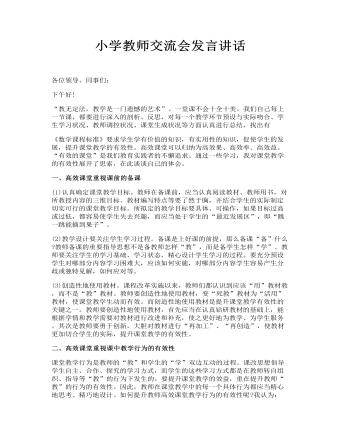
小学教师交流会发言讲话
高效课堂重视课前的备课(1)认真确定课堂教学目标。教师在备课前,应当认真阅读教材、教师用书,对所教授内容的三维目标、教材编写特点等要了然于胸,并结合学生的实际制定切实可行的课堂教学目标。所拟定的教学目标要具体、可操作,如果目标过高或过低,都容易使学生失去兴趣,而应当处于学生的“最近发展区”,即“跳一跳能摘到果子
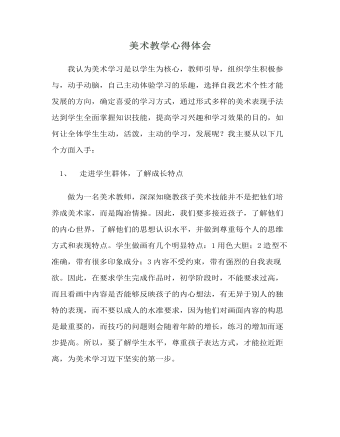
美术教学心得体会
1、 走进学生群体,了解成长特点 做为一名美术教师,深深知晓教孩子美术技能并不是把他们培养成美术家,而是陶冶情操。因此,我们要多接近孩子,了解他们的内心世界,了解他们的思想认识水平,并做到尊重每个人的思维方式和表现特点。学生做画有几个明显特点:1用色大胆;2造型不准确,带有很多印象成分
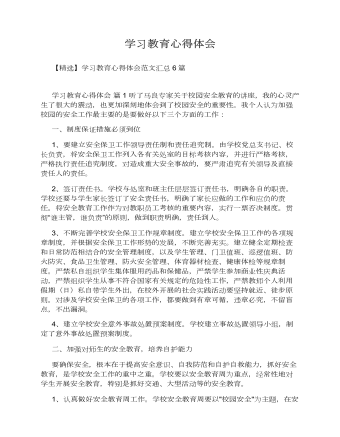
学习教育心得体会
2、签订责任书。学校与处室和班主任层层签订责任书,明确各自的职责。学校还要与学生家长签订了安全责任书,明确了家长应做的工作和应负的责任。将安全教育工作作为对教职员工考核的重要内容,实行一票否决制度。贯彻“谁主管,谁负责”的原则,做到职责明确,责任到人。 3、不断完善学校安全保卫工作规章制度。建立学校安全保卫工作的各项规章制度,并根据安全保卫工作形势的发展,不断完善充实。建立健全定期检查和日常防范相结合的安全管理制度,以及学生管理、门卫值班、巡逻值班、防火防灾、食品卫生管理、防火安全管理、体育器材检查、健康体检等规章制度。严禁私自组织学生集体服用药品和保健品,严禁学生参加商业性庆典活动,严禁组织学生从事不符合国家有关规定的危险性工作,严禁教师个人利用假期(日)私自带学生外出,在校外开展的社会实践活动要坚持就近、徒步原则。对涉及学校安全保卫的各项工作,都要做到有章可循,违章必究,不留盲点,不出漏洞。
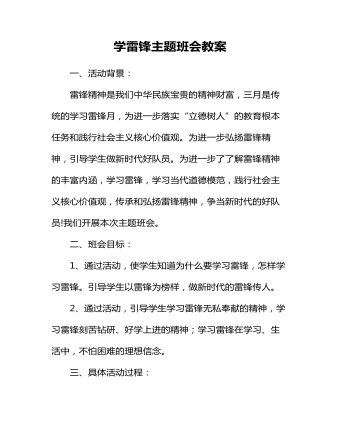
学雷锋主题班会教案
一、活动背景:雷锋精神是我们中华民族宝贵的精神财富,三月是传统的学习雷锋月,为进一步落实“立德树人”的教育根本任务和践行社会主义核心价值观。为进一步弘扬雷锋精神,引导学生做新时代好队员。为进一步了了解雷锋精神的丰富内涵,学习雷锋,学习当代道德模范,践行社会主义核心价值观,传承和弘扬雷锋精神,争当新时代的好队员!我们开展本次主题班会。二、班会目标:1、通过活动,使学生知道为什么要学习雷锋,怎样学习雷锋。引导学生以雷锋为榜样,做新时代的雷锋传人。2、通过活动,引导学生学习雷锋无私奉献的精神,学习雷锋刻苦钻研、好学上进的精神;学习雷锋在学习、生活中,不怕困难的理想信念。
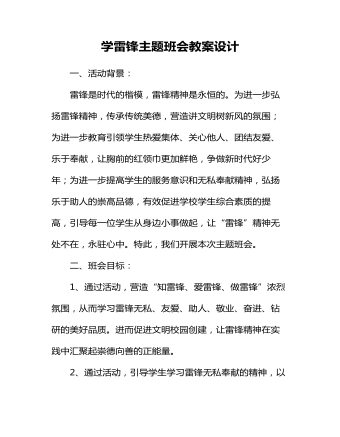
学雷锋主题班会教案设计
一、活动背景:雷锋是时代的楷模,雷锋精神是永恒的。为进一步弘扬雷锋精神,传承传统美德,营造讲文明树新风的氛围;为进一步教育引领学生热爱集体、关心他人、团结友爱、乐于奉献,让胸前的红领巾更加鲜艳,争做新时代好少年;为进一步提高学生的服务意识和无私奉献精神,弘扬乐于助人的崇高品德,有效促进学校学生综合素质的提高,引导每一位学生从身边小事做起,让“雷锋”精神无处不在,永驻心中。特此,我们开展本次主题班会。二、班会目标:1、通过活动,营造“知雷锋、爱雷锋、做雷锋”浓烈氛围,从而学习雷锋无私、友爱、助人、敬业、奋进、钻研的美好品质。进而促进文明校园创建,让雷锋精神在实践中汇聚起崇德向善的正能量。2、通过活动,引导学生学习雷锋无私奉献的精神,以实际行动学习雷锋精神,践行雷锋精神,把雷锋精神代代传承下去。3、通过活动,引导学生在学习和生活中用实际行动去发扬雷锋艰苦朴素的优良作风和乐于助人的奉献精神,真正从自身做起,从点滴做起,从今天做起。
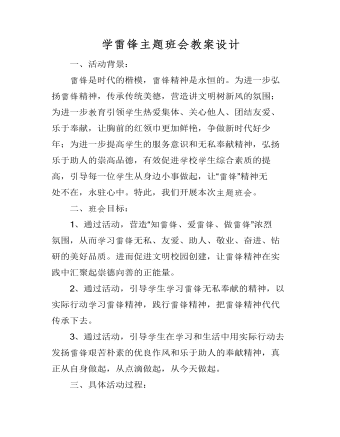
学雷锋主题班会教案设计
1、通过活动,营造“知雷锋、爱雷锋、做雷锋”浓烈氛围,从而学习雷锋无私、友爱、助人、敬业、奋进、钻研的美好品质。进而促进文明校园创建,让雷锋精神在实践中汇聚起崇德向善的正能量。

学雷锋主题班会教案
二、班会目标:1、通过活动,使学生知道为什么要学习雷锋,怎样学习雷锋。引导学生以雷锋为榜样,做新时代的雷锋传人。2、通过活动,引导学生学习雷锋无私奉献的精神,学习雷锋刻苦钻研、好学上进的精神;学习雷锋在学习、生活中,不怕困难的理想信念。
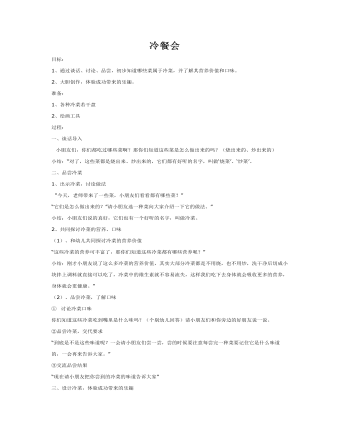
大班科学教案:冷餐会
一、谈话导入 小朋友们,你们都吃过哪些菜啊?那你们知道这些菜是怎么做出来的吗?(烧出来的、炒出来的) 小结:“对了,这些菜都是烧出来、炒出来的,它们都有好听的名字,叫做‘烧菜’、‘炒菜’。 二、品尝冷菜 1、出示冷菜,讨论做法 “今天,老师带来了一些菜,小朋友们看看都有哪些菜?” “它们是怎么做出来的?”请小朋友选一种菜向大家介绍一下它的做法。” 小结:小朋友们说的真好,它们也有一个好听的名字,叫做冷菜。 2、共同探讨冷菜的营养、口味 (1)、和幼儿共同探讨冷菜的营养价值 “这些冷菜的营养可丰富了,那你们知道这些冷菜都有哪些营养呢?” 小结:刚才小朋友说了这么多冷菜的营养价值,其实大部分冷菜都是不用烧,也不用炒,洗干净后切成小块拌上调料就直接可以吃了,冷菜中的维生素就不容易流失,这样我们吃下去身体就会吸收更多的营养,身体就会更健康。” (2)、品尝冷菜,了解口味
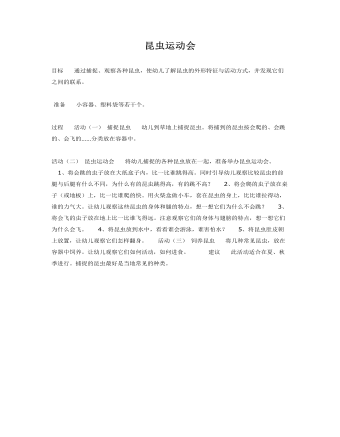
大班科学教案:昆虫运动会
准备 小容器、塑料袋等若干个。 过程 活动(一)捕捉昆虫 幼儿到草地上捕捉昆虫。将捕到的昆虫按会爬的、会跳的、会飞的……分类放在容器中。 活动(二)昆虫运动会 将幼儿捕捉的各种昆虫放在一起,准备举办昆虫运动会。 1、将会跳的虫子放在大纸盒子内,比一比谁跳得高。同时引导幼儿观察比较昆虫的前腿与后腿有什么不同,为什么有的昆虫跳得高,有的跳不高?
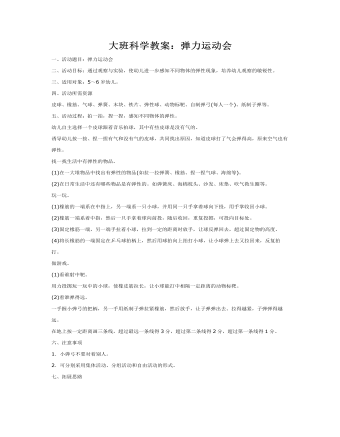
大班科学教案:弹力运动会
二、活动目标:通过观察与实验,使幼儿进一步感知不同物体的弹性现象,培养幼儿观察的敏锐性。三、适用对象:5~6岁幼儿。四、活动所需资源皮球、橡筋、气球、弹簧、木块、铁片、弹性球、动物标靶、自制弹弓(每人一个)、纸制子弹等。五、活动过程:拍一拍,捏一捏,感知不同物体的弹性。幼儿自主选择一个皮球跟着音乐拍球,其中有些皮球是没有气的。诱导幼儿按一按、捏一捏有气和没有气的皮球,共同找出原因,知道皮球打了气会弹得高,原来空气也有弹性。找一找生活中有弹性的物品。(1)在一大堆物品中找出有弹性的物品(如拉一拉弹簧、橡筋、捏一捏气球、海绵等)。(2)在日常生活中还有哪些物品是有弹性的。如弹簧床、海棉枕头、沙发、床垫、吹气救生圈等。玩一玩。(1)橡筋的一端系在中指上,另一端系一只小球,并用同一只手拿着球向下投,用手掌收回小球。(2)橡筋一端系着中指,然后一只手拿着球向前投,随后收回,重复投掷,可投向目标处。(3)固定橡筋一端,另一端手拉着小球,拉到一定的距离时放手,让球反弹回去,超过固定物的高度。(4)将长橡筋的一端固定在乒乓球拍柄上,然后用球拍向上拍打小球,让小球弹上去又拉回来,反复拍打。做游戏。

中班数学教案:会变的图形
教学准备: 正方形纸、小刀。 教学过程: (一)变魔术 让幼儿猜想正方形能不能变成三角形、小正方形、长方形。然后将纸折叠,剪开变为各种图形。 将剪开的图形再拼成正方形。
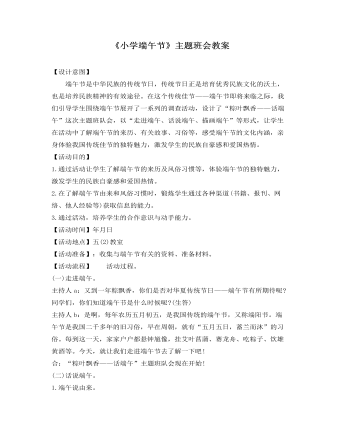
《小学端午节》主题班会教案
主b:一直到今天,每年五月初五,中国百姓家家都要浸糯米、洗粽叶、包粽子,其花色品种琳琅满目。除了这些,你们还知道端午节哪些习俗的由来呢?(生结合屈原和黄巢的故事谈喝雄黄酒、悬艾草的由来) 主b:端午的时候,人们还要佩香囊、撮五彩线呢,你们知道五彩线由哪五种颜色组成呢?人们为什么撮五彩线呢? (五彩线是用五种颜色的线制成。这五种颜色不是随便用哪五种颜色就行,而必须是 青、白、红、黑和黄色。这五种颜色从阴阳五行学说上讲,分别代表木、金、火、水、土。同时,分别象征东、西、南、北、中,蕴涵着五方神力,可以驱邪除魔,祛病强身,使人健康长寿。五彩线象征五色龙,系五色线可以降服妖魔鬼怪。民间喜欢用五彩线系在儿童手腕上(男左女右),俗称“长命线”,以祈求压邪避毒,长命百岁。) 3.端午赛诗会。 主a:我们知道屈原是一位伟大的爱国诗人,为了纪念他,所以有人把端午节还称作“诗人节”。现在谁来朗诵一首与端午节有关的诗篇。(生可以选择其他与端午节有关的诗篇)
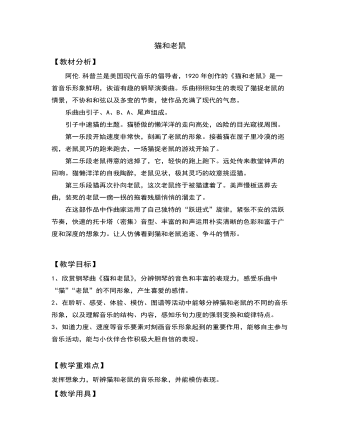
二年级音乐欣赏猫和老鼠教案教学设计
阿伦.科普兰是美国现代音乐的倡导者,1920年创作的《猫和老鼠》是一首音乐形象鲜明,诙谐有趣的钢琴演奏曲。乐曲栩栩如生的表现了猫捉老鼠的情景,不协和和弦以及多变的节奏,使作品充满了现代的气息。乐曲由引子、A、B、A、尾声组成。引子中速猫的主题。猫骄傲的懒洋洋的走向高处,凶险的目光窥视周围。第一乐段开始速度非常快,刻画了老鼠的形象。接着猫在屋子里冷漠的巡视,老鼠灵巧的跑来跑去,一场猫捉老鼠的游戏开始了。第二乐段老鼠得意的逃掉了,它,轻快的跑上跑下。远处传来教堂钟声的回响。猫懒洋洋的自我陶醉,老鼠见状,极其灵巧的故意挑逗猫。第三乐段猫再次扑向老鼠,这次老鼠终于被猫逮着了。美声慢板送葬去曲,装死的老鼠一瘸一拐的拖着残腿悄悄的溜走了。在这部作品中作曲家运用了自己独特的“跃进式”旋律,紧张不安的活跃节奏,快速的托卡塔(密集)音型、丰富的和声运用朴实清晰的色彩和富于广度和深度的想象力。让人仿佛看到猫和老鼠追逐、争斗的情形。

